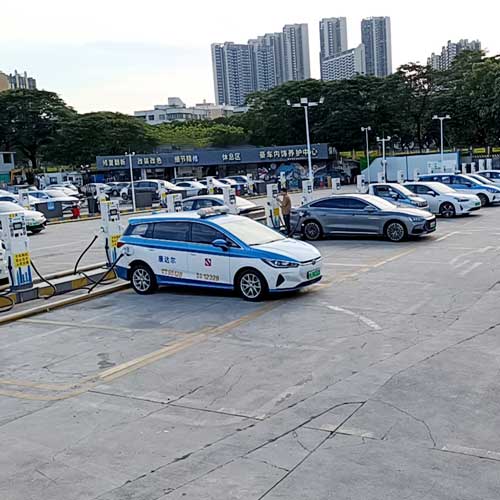-
 +86 18924678741
+86 18924678741 -
 sales@hjlcharger.com
sales@hjlcharger.com -
 Shenzhen City, Guangdong Province, China
Shenzhen City, Guangdong Province, China
Electric charging points refer to places or facilities that provide charging services for electric vehicles. With the popularity of electric vehicles, the construction and optimization of electric charging points have become particularly important. The following is a detailed introduction to electric charging points:
1. Types of electric charging points
Government professional charging service outlets:
The government has established large-scale charging station outlets in major cities, counties, towns, public institutions and public service units.
These outlets provide services for electric vehicle charging through support and subsidy policies, with high reliability and convenience.
Commercial area charging facilities:
Relatively small charging piles can be found in hotels, office buildings, large shopping malls and public parking lots in commercial areas.
These charging piles are convenient for electric vehicle users to charge while shopping or working.

Charging points inside buildings:
There are some charging points inside residential areas, office buildings, shops and other buildings.
These charging points can charge electric vehicles as long as there is power supply, which is suitable for electric vehicle users to charge at home or near the workplace.
Personal home charging:
Electric vehicle users can connect charging piles at home and charge using the power supply at home.
This method requires users to purchase and install charging piles by themselves and ensure the safety of the charging process.
2. Requirements for setting up electric charging points
Indoor charging points:

Indoor electric vehicle parking and charging places should be set up independently and effectively separated from other parts of the building by fire protection.
A dedicated charging distribution box should be set up for the charging equipment line, and the charging device should have functions such as timed charging, automatic power off, overload protection, short circuit protection and leakage protection.
The number of charging sockets connected to each branch circuit should not exceed the specified number, and the electrical lines should be buried or protected by insulating sleeves.
Indoor places should also be equipped with fire protection facilities such as automatic sprinkler fire extinguishing systems, automatic fire alarm systems, indoor fire hydrant systems and smoke exhaust facilities.
Outdoor charging points:

Outdoor electric vehicle parking and charging places should be set up independently in reasonable locations and should not occupy fire protection distances, fire truck passages and fire truck climbing operation sites.
The distribution box in outdoor places should be fixed on the pillars of the carport or on the outer wall of the carport, and should be designed to be rainproof.
The charging device should also have functions such as timed charging, automatic power off, overload protection, short circuit protection and leakage protection.
3. Optimization measures for electric charging points
Increase the number of charging facilities:
Rationally plan and increase the number of charging facilities according to the needs and distribution of electric vehicle users.
Add charging piles in residential areas, commercial areas, public parking lots and other areas with dense electric vehicles.
Improve the quality of charging facilities:
Select charging equipment and materials with reliable quality and stable performance.
Inspect and maintain charging facilities regularly to ensure their normal operation and safety.
Optimize charging services:
Provide convenient charging reservation and payment services to facilitate users to charge at any time.
Strengthen the informatization construction of charging facilities to achieve real-time monitoring and management of charging data.
4. Safety issues of electric charging points
Avoid overcharging:
Electric vehicle users should pay attention to avoid long-term charging or overcharging to avoid safety issues such as battery explosion or charger self-ignition.
Use original charger:
It is recommended that users use original chargers or chargers with overcharge protection for charging, and avoid using fast charging or unmatched informal chargers.
Pay attention to the charging environment:
When charging, ensure that the battery voltage is stable, and the battery and charger should not be covered by objects to prevent high-temperature self-ignition.
Do not charge immediately after driving, and charge after cooling for half an hour.
In summary, electric charging points are important places for electric vehicle users to charge. The government, enterprises and individuals should work together to rationally plan, build and optimize electric charging points to provide electric vehicle users with more convenient, safe and reliable charging services.
If you want to know more about "electric charging points", you can consult us online or by email (sales@hjlcharger.com).
Prev:public electric car charging
Next:electric charger
Mid-Autumn Festivaland National DayHoliday NoticeA...
Focus on the future of energy and start a green ch...
Top 10 charging and swapping brandsTop 10 brands i...
For ev chargers in Thailand, l
Electric charging stations greece: the battle for ...
The selection of the best ev c
Installing public ev charging stations is a projec...
7kw ev charger how long to charge? A 7kw ev charge...
How many kW does a Level 2 charger use?The power u...
Hongjiali New Energy provides fast, port
Product numberDCL030A-V2GDetailed specif
Hongjiali ev charging solutions for gas
Buy ev DC charger with payment system at
Whenever you need us, we're here for you. --- Contact us for all your support needs, from technology, general queries to information support, etc. Our hotline numbers and e-mail are open 24hx7d for your needs.

 +86 18924678741
+86 18924678741 sales@hjlcharger.com
sales@hjlcharger.com Shenzhen City, Guangdong Province, China
Shenzhen City, Guangdong Province, China